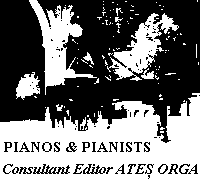|
 |
JAN LADISLAV DUSSEK : 2
Bohemian Romantic
(1760-1812)
|
<< Continued from 7th May
Le beau Dussek
Admired for his tonal palette, 'enchanted' touch, innovative (shifting)
legato fingerings prophetic of Chopin ('to hold the vibration and
to tie or bind one passage to another,' he called it), pedalling (in which
area he was far in advance of Hummel), and emotionally intense artistry,
for his fanciful way with fioritura elaboration, Dussek, le beau
Dussek, was among the first of the great travelling showman pianists, a
generation or more in advance of Liszt. William Ayrton of the Philharmonic
Society, writing in Vol IV of The Musical Library (March 1837), called
him 'a pianist of the highest rank [whose] best compositions have not been
excelled'.
The Composer
Dussek's repeatedly been singled out for the progressiveness, the advanced
chromaticism, of his harmonic language. For his approach to tonality and
unorthodox key relationships (at times remarkably anticipant of things to
come in Chopin, Schumann and Brahms). And for his formal innovations - beckoning
as much ideas in Beethoven (a subject discussed famously by the late Harold
Truscott in the Arnold & Fortune Beethoven Companion of
1971) as Weber or Chopin, Liszt or Smetana. He wrote over thirty piano sonatas
- between 1788, the year of Mozart's final trilogy of symphonies, and 1812,
the year of Beethoven's Seventh and Eighth.
The Pianist
Contemporaries and chroniclers of the day celebrated Dussek for his lyrically
poetic dreaming no less than romantically fiery brilliance: the character
and virtuosity of his keyboard style, his figurations, his specifically
marked pedal indications (as early as the B flat Military Concerto
of 1798, some five or six years before the Beethoven Waldstein),
his fingerings, his way of generating sonority and resonance (albeit through
illusion) - all mark him to have been an artist eager to identify with the
potential and power of the new-breed Hammerklavier, a man anxious
to take advantage of the innovations of such makers as Broadwood (in London),
Erard (Paris) or Graf (Vienna). Essentially, like Beethoven and Schubert,
he was a modern pianist writing for the modern piano. Historically, he had
to content himself with straight-strung, wooden-framed, pre-double-escapement
instruments. But what he really aspired to were the over-strung, iron-cast,
double-escapement beasts of more than half a century later.
Bohemian Romantic!
Dussek, his detractors claim, sounds just like any other composer - Beethoven,
Schubert, Weber, Rossini, Mendelssohn, Chopin, Schumann, Smetana, Liszt
... Not a bit of it, retort his supporters. On the contrary, they say, what
apparent likenesses there are mostly post-dated his passing: 'such
resemblances show him [in chronological fact] to have been very much ahead
of his time in the development of a Romantic piano style' (Howard Allen
Craw, The New Grove, 1980) If a period needs perspective to give
it focus, then the Age of Beethoven needed its Dussek. The Bohemian Romantic
supreme, a colourfully charismatic personality who fed the wellsprings of
the Beethoven/Schubert style and was a direct link between the galanterie
and classicism of Mozart and the emotional flowering to come of Schumann,
Chopin and Smetana, he was one of the radical freewheelers of the Napoleonic
era.
© Ates Orga, May 21st 1999
A revised version of a longer essay published originally as part of the
South Bank Centre's Beethoven Plus Festival, London November
1988
Hear
Dussek's Piano Concertos in B flat, Op 22
and G minor, Op 49
with Concerto Köln and
Andreas Staier
playing a Broadwood English Grand Action piano of 1806
Capriccio 10 444
DDD
1992 recording, released 1995
|
Pianos & Pianists Main Page >>
|